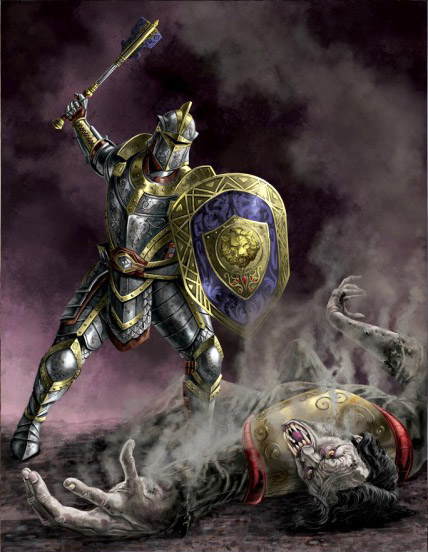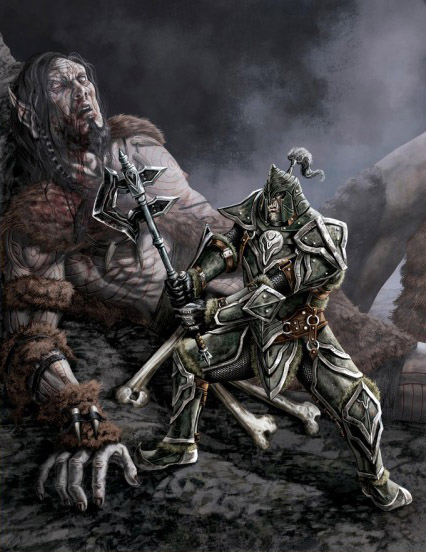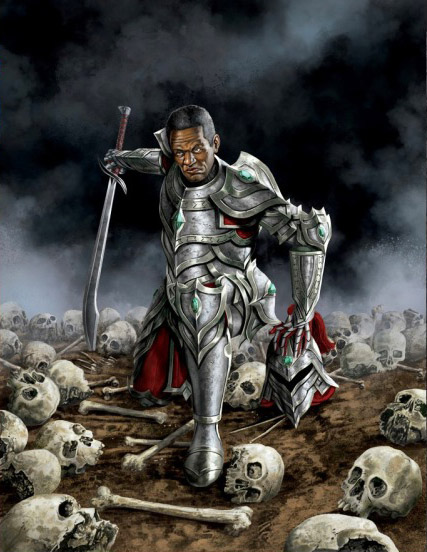Gathering Force/Chapter 2
Real author : David S. J. Hodgson (Writter), Caio Cacau (Artist) Original media : The Hero's Guides to The Elder Scrolls Online
By Longinus Attius, 2E 581
M ANY OF THE men of High Rock feel a wistful dalliance with the supernatural or a bend with the mercantile life, but this caused a loss of loan on the might of steel or the savagery of the blade. Our cousins to the northwest are canny to have brokered the Daggerfall Covenant and remain united behind High King Emeric. For his grip across northern Tamriel to remain strong, a standing army, from the lowliest man-at-arms to the Lion Guard captain, must be ready to defend their quaint and picturesque province. While they are not regimented and trained to the same quality as an Imperial force, we share more similarities and less divides us, especially compared to the filthy Nord or the beastling clad in scales or fur. I intend no disrespect with my words.
Breton armor is wonderfully dependable, in terms of both strength and comfort. From the comb sitting atop the heavier helms to the overlapped steel lames that harness you in tight, construction from the very finest blacksmiths offers protection without the constant need for rubbing ointments. Tanning is almost seen as a fine art, and many quality pieces use softer, more pliable leathers (from guar or cattle) at the joints of the gorget collar, and thicker pieces (from the wolf) at the vambrace. For those of a foppish disposition with an overabundance of wealth, additional minerals can be added in the forging process to vary the color of the plates, from a deep red to a marbled white. In the main, Breton arms are of a standard fare. When one conjures the picture of a sword in the mind's eye, a Breton blade usually appears. But do not think these weapons are in any way unvaried or tedious. From the finial carving atop a staff to the quillon block of a dagger, expect an element of curved carving most pleasing to view, and the use of enchanted gemstones, and an overabundance of lion heads when shields are raised or when Wayrest is your journey's end. But it is the inclusion of orichalcum, conjoined to the base metal of the very best weaponry a Breton has to hand, that proves the might of the master merchants. Fine, sturdy, and of quality craftsmanship, a Breton's blade, bow, or shield has a pleasing weight, if perhaps an overabundance of heraldry and pattern work.
S LOWLY WINNING THE begrudging respect of the Empire, the barbarian beasts of the Dragontail and Wrothgarian Mountains are more at home than most on the frontlines of a battlefield. Though many of the more cultured races still harbor resentment of their boorish ways, and one never talks to an Orc without hearing a brooding, oppressive moaning, their forges rage with deep heat. Indeed, their craft work reveals a heft no other blacksmith can match, a product of the Orc's historic hardships, cunning resolve, and brutish power.
If you are of a more dainty disposition, Orcish armor is not appropriate attire for you. I've seen a previously sturdy Argonian struggle into an Orc's thick plate, be struck about the face and nethers as he attempted to turn on his assailants, and collapse under the sheer weight of his protection. Even Nords fare little better, red checked and cursing after minutes of combat practice clad in this deluge of steel. But the Orc, who has worked with the tremendous weight of his armor since childhood and has the frame to carry it, shrugs off the chafing and immobility as just another hardship to endure. Orcish armor is thick and functional. The edges are sharp and jagged, as there is no word in the Orcish tongue for delicacy. Gauntlets and sabatons are punctuated with sharp spines to provide further anguish to those punched, booted, or otherwise manhandled. To prevent self-inflicted wounds, fur is sewn into the folds, further increasing the bulk. For the veteran pulverizer, attempts at ornate design are made, with curved layers of steel under chain mail. Weapons are carried with pride and suffer from the same ludicrous lack of subtlety, although the cracked skulls of many a Falkreath Nord should leave one in no doubt of their effectiveness. Though Orcs tend to shun magic, they stare at enchantments as a dog might at a roasted beef steak, mesmerized by pretty colors and the prospect of additional savagery to inflict. These lumbering tools of destruction often feature numerous references to the Code of Malacath, named for their great chief and arch bloodletter, or his grimacing face.
T HOUGH THE SKILLED war practitioners of our Glorious Empire might rightly disagree, many seem under the misapprehension that the Redguard warriors are the most naturally gifted. While their stature and fleetness of foot allow them to excel in the fields of scouting or skirmishing, their misplaced independence and fierce pride mean these desert dwellers take to direction from their betters with the obstinate detachment of a stubborn pack horse.
Although our champion has donned the finest heavy armor of the province, most sword folk of the Redguard persuasion prefer their garments billowing, pale in color, and perchance with scalp-shading head attire and calf sandals. When leather is discarded in favor of metal, it is clasped together as an outer skin, wrapping the body tightly, but with flexibility of design (such as the fronded tasset allowing for bending and dexterous combat agility). Redguards never miss a chance to fuse gemstones to their breastplates or poleyns, as if commanded to by Tall Papa himself. The majority of Redguard weaponry shares a similar construction and filigree. Turquoise and amethyst gems are embedded into a staff's zenith or a sword's pommel and provide decoration to shields. Steel and gold embossing is common. Pieces are heavily wrapped with guar or kagouti leather, which, with their hard-wearing nature and pleasing brown hue, are stitched to the grip and tang. Also expect ever more elaborate carving on the weightier or more finely forged blades, patterns harking back to Yokudan traditions of the sword saint. The Redguard favor quickness over mass in their oddly curved swords; they are light to hold, compared to the weapons a Breton or a Nord might clash with. Blunt or chopping instruments have fallen out of favor with our dark-hued friends, but are still forged for those not besotted with "the old ways." Aside from the scimitar, these examples of Redguard weaponry are rarely used. Expect carvings of lions, horses, water, and Satakal, the self-devouring snake.
|












